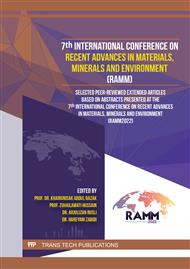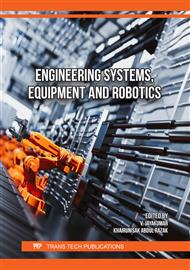[1]
H.T.B.M. Petrus et al., "Cenospheres characterization from Indonesian coal-fired power plant fly ash and their potential utilization," J. Environ. Chem. Eng., vol. 8, no. 5, p.104116, 2020, doi:10.1016lj.jece.2020.104116.
DOI: 10.1016/j.jece.2020.104116
Google Scholar
[2]
U. S. Agrawal and S. P. Wanjari, "Physiochemical and engineering characteristics of cenosphere and its application as a lightweight construction material- A review," in Materials Today: Proceedings, Jan. 2017, vol. 4, no. 9, pp.9797-9802, doi: 10.1016lj.matpr.2017.06.269.
DOI: 10.1016/j.matpr.2017.06.269
Google Scholar
[3]
I. Nawaz, "Disposal and Utilization of Fly Ash to Protect the Environment," Int. J. Innov. Res. Sci. Eng. Technol., vol. 2, no. 10, pp.5259-5266, 2013.
Google Scholar
[4]
H.P. Jambhulkar, S. M. S. Shaikh, and M. S. Kumar, "Fly ash toxicity, emerging issues and possible implications for its exploitation in agriculture; Indian scenario: A review," Chemosphere, vol. 213, pp.333-344, Oec. 2018, doi: 10.1016lJ.CHEMOSPHERE. 2018.09.045.
DOI: 10.1016/j.chemosphere.2018.09.045
Google Scholar
[5]
P. J. A. Borm, "Toxicity and occupational health hazards of coal fly ash (CFA). A review of data and comparison to coal mine dust," Annals of Occupational Hygiene, vol. 41, no. 6. Elsevier Science Ltd, pp.659-676, Oec. 01, 1997, doi: 10.1016lS0003-4878(97)00026-4.
DOI: 10.1016/s0003-4878(97)00026-4
Google Scholar
[6]
J. Li et al., "Recovery and concentration of buoyant cenospheres using an Inverted Reflux Classifier," Fuel Process. Technol., vol. 123, no. July, pp.127-139, 2014, doi:10.1016lj.fuproc. 2014.01.043.
DOI: 10.1016/j.fuproc.2014.01.043
Google Scholar
[7]
N. Ranjbar and C. Kuenzel, "Cenospheres: A review," Fuel, vol. 207. Elsevier Ltd, pp.1-12, Nov. 01, 2017, doi: 10.1016lj.fuel.2017.06.059.
DOI: 10.1016/j.fuel.2017.06.059
Google Scholar
[8]
A. Adesina, "Sustainable application of cenospheres in cementitious materials - Overview of performance," Dev. Built Environ., vol. 4, no. September, p.100029, 2020, doi:10.1016lj.dibe. 2020.100029.
DOI: 10.1016/j.dibe.2020.100029
Google Scholar
[9]
A. G. Castellanos, H. Mawson, V. Burke, and P. Prabhakar, "Fly-ash cenospherelclay blended composites for impact resistant tiles," Constr. Build. Mater., vol. 156, pp.307-313, 2017, doi:10.1016lj.conbuildmat.2017.08.151.
DOI: 10.1016/j.conbuildmat.2017.08.151
Google Scholar
[10]
T. Hirajima, H. T. B. M. Petrus, Y. Oosako, M. Nonaka, K. Sasaki, and T. Ando, "Recovery of cenospheres from coal fly ash using a dry separation process: Separation estimation and potential application," Int. J. Miner. Process., vol. 95, no. 1-4, pp.18-24, 2010, doi:10.1016lj.minpro. 2010.03.004.
DOI: 10.1016/j.minpro.2010.03.004
Google Scholar
[11]
H. T. B. M. Petrus, T. Hirajima, Y. Oosako, M. Nonaka, K. Sasaki, and T. Ando, "Performance of dry-separation processes in the recovery of cenospheres from fly ash and their implementation ina recovery unit," Int. J. Miner. Process., vol. 98, no. 1-2, pp.15-23, Jan. 2011, doi:10.1016lj.minpro. 2010.09.002.
DOI: 10.1016/j.minpro.2010.09.002
Google Scholar
[12]
O. Yinfei, X. Ling, O. Haibin, O. Oeyi, W. Hao, and L. Weidong, "Evaluation of thermal behavior and high-temperature performances of asphalt mixture containing fly ash cenosphere," Constr. Build. Mater., vol. 245, p.118429, 2020, doi: 10.1016lj.conbuildmat.2020.118429.
DOI: 10.1016/j.conbuildmat.2020.118429
Google Scholar
[13]
L. M. Manocha, K. A. Ram, and S. M. Manocha, "Separation of cenospheres from Fly Ashes by Floatation method," Eurasian Chem. J., vol. 13, no. 1-2, pp.89-95, 2011, doi: 10.18321lectj72.
DOI: 10.18321/ectj72
Google Scholar
[14]
I. Acar and M. U. Atalay, "Recovery potentials of cenospheres from bituminous coal fly ashes," Fuel, vol. 180, pp.97-105, Sep. 2016, doi: 10.1016lj.fuel.2016.04.013.
DOI: 10.1016/j.fuel.2016.04.013
Google Scholar
[15]
A. Chavez-Valdez, A. Arizmendi-Morquecho, G. Vargas, J. M. Almanza, and J. Alvarez- Quintana, "Ultra-low thermal conductivity thermal barrier coatings from recycled fly-ash cenospheres," Acta Mater., vol. 59, no. 6, pp.2556-2562, Apr. 2011, doi:10.1016lj.actamat. 2011.01.011.
DOI: 10.1016/j.actamat.2011.01.011
Google Scholar
[16]
V. Tiwari, A. Shukla, and A. Bose, "Acoustic properties of cenosphere reinforced cement and asphalt concrete," Appl. Acoust., vol. 65, no. 3, pp.263-275, Mar. 2004, doi:10.1016lj.apacoust.2003.09.002.
DOI: 10.1016/j.apacoust.2003.09.002
Google Scholar
[17]
R. Jing, Y. Liu, and P. Yan, "Uncovering the effect of fly ash cenospheres on the macroscopic properties and microstructure of ultra-high-performance concrete (UHPC)," Constr. Build. Mater., vol. 286, p.122977, Jun. 2021, doi: 10.1016lj.conbuildmat.2021.122977.
DOI: 10.1016/j.conbuildmat.2021.122977
Google Scholar
[18]
S. Yoriya, T. Intana, and P. Tepsri, "Separation of cenospheres from lignite fly ash using acetone-water mixture," Appl. Sci., vol. 9, no. 18, 2019.
DOI: 10.3390/app9183792
Google Scholar
[19]
V. V. Zyryanov and D. V. Zyryanov, "Complex Processing of Pulverized Fly Ash by Dry Separation Methods," J. Environ. Prot. (Irvine,. Calif)., vol. 01, no. 03, pp.293-301, 2010, doi:10.4236ljep.2010.13035.
DOI: 10.4236/jep.2010.13035
Google Scholar
[20]
Kashan Bashir, "Design and fabrication of cyclone separator," ResearchGate, no. August 2015,2015, doi: 10.13140lRG.2.2.20727.83368.
Google Scholar
[21]
K. S. Lim, H. S. Kim, and K. W. Lee, "Characteristics of the collection efficiency for a cyclone with different vortex finder shapes," J. Aerosol Sci., vol. 35, no. 6, pp.743-754, Jun. 2004, doi:10.1016lj.jaerosci.2003.12.002.
DOI: 10.1016/j.jaerosci.2003.12.002
Google Scholar
[22]
G. Yu et al., "Experimental and numerical studies on a new double-stage tandem nesting cyclone," Chem. Eng. Sci., vol. 236, p.116537, Jun. 2021.
DOI: 10.1016/j.ces.2021.116537
Google Scholar
[23]
B. Pei, L. Yang, K. Dong, Y. Jiang, X. Du, and B. Wang, "The effect of cross-shaped vortex finder on the performance of cyclone separator," Powder Technol., vol. 313, pp.135-144, 2017, doi: 10.1016lj.powtec.2017.02.066.
DOI: 10.1016/j.powtec.2017.02.066
Google Scholar
[24]
K. Elsayed and C. Lacor, "Numerical modeling of the flow field and performance in cyclones of different cone-tip diameters," Comput. Fluids, vol. 51, no. 1, pp.48-59, Oec. 2011, doi: 10.1016lj.compfluid.2011.07.010.
DOI: 10.1016/j.compfluid.2011.07.010
Google Scholar
[25]
F. Ficici, A. Vedat, and M. Kapsiz, "The effects of vortex finder on the pressure drop in cyclone separators," Int. J. Phys. Sci., vol. 5, no. 6, pp.804-813, 2010.
Google Scholar
[26]
K. J. Hwang and S. P. Chou, "Designing vortex finder structure for improving the particle separation efficiency of a hydrocyclone," Sep. Purif. Technol., vol. 172, pp.76-84, 2017, doi: 10.1016lj.seppur. 2016.08.005.
DOI: 10.1016/j.seppur.2016.08.005
Google Scholar
[27]
F. Y. A. Saputra, Sutijan, and H. T. B. M. Petrus, "Cenosphere Separation from Fly Ash Using Modified Gravity Separator: Feed Ratio Assessment and Stream Velocity Optimization," IOP Conf. Ser. Mater. Sci. Eng., vol. 742, no. 1, 2020, doi: 10.1088l1757-899Xl742l1l012006.
DOI: 10.1088/1757-899x/742/1/012006
Google Scholar
[28]
K. Dewettinck and A. Huyghebaert, "Fluidized bed coating in food technology," Trends Food Sci. Technol., vol. 10, no. 4-5, pp.163-168, Apr. 1999, doi: 10.1016lS0924-2244(99)00041-2.
DOI: 10.1016/s0924-2244(99)00041-2
Google Scholar
[29]
G. Berkowicz, D. Bradlo, and W. Żukowski, "Cenospheres as an innovative fluidised bed material," Cenospheres as an Innov. Fluid. bed Mater., vol. 2016, no. 4, pp.1-10, 2016, doi: 10.4467l2353737XCT.16.041.5303.
Google Scholar
[30]
J. Wrona, W. Zukowski, D. Bradlo, and P. Czuprynśki, "Recovery of cenospheres and fine fraction from coal fly ash by a novel dry separation method," Energies, vol. 13, no. 14, pp.1-14, 2020, doi: 10.3390len13143576.
DOI: 10.3390/en13143576
Google Scholar
[31]
Cenostar Corp., "Cenostar," 20 May 2022. [Online]. Available: https:llwww.cenostar.comlpageslcollection-cenospheres.
Google Scholar
[32]
BariteWorld Corp, "BariteWorld," [Online]. Available: https:llbariteworld.comlindustrial- minerals-productslcenospheresl. [Accessed 20 May 2022].
Google Scholar



